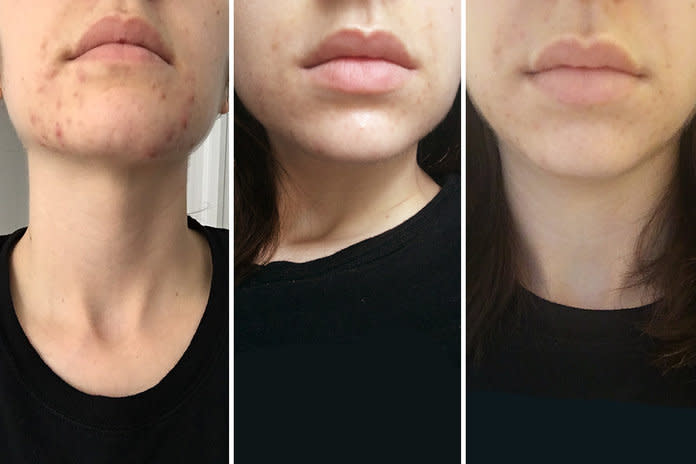This Pill May Be the Answer to Fighting Hormonal Acne

As a teenager up until my mid 20s I used to be that annoying person with perfect, clear skin. Throughout high school, college, and going into my post-grad years, my skincare routine would best be described as minimalist and just consisted of the following: Cetaphil Gentle Facial Cleanser ($10; target.com) to remove dirt and makeup, treated my under eye area with Dermalogica AGE Smart Age Reversal Eye Complex ($78; nordstrom.com), and moisturizing with Kiehl’s Ultra Facial Moisturizer ($28; nordstrom.com). I never broke out except for the occasional whitehead around my period.
And then I turned 28.
Just as fast as my late 20s creeped up on me, so did hormonal acne. It started with a few cystic bumps on my chin that wouldn’t shrink no matter what spot treatment I used. The situation escalated quickly when the blemishes multiplied and turned into a full-blown infestation around my mouth, chin, and jawline. It didn’t matter what day of my cycle I was on, I would wake up with new pimples every day. Even though the breakouts would happen on random days in the month, the fact that they were all cystic and stuck to the lower half of my face led me to believe the cause was hormonal.
RELATED: This Is How You Should Be Applying Your Eye Cream
Dealing with acne is frustrating no matter which way you put it, but when you (luckily) manage to go through your entire adolescence pimple-free, to say that developing acne in your adult life is tough, is a massive understatement. It's especially true if you're taking great care not to exacerbate the situation. Since my breakouts were immune to every topical treatment I tried—whether it was clinical or natural—I Googled alternative solutions for getting hormonal acne under control. For about a year I tried everything from alternating my diet by cutting out dairy, which has been linked to hormonal acne, to making sure I regularly exercised to reduce stress, and hopefully, my breakouts.
When going dairy-free and working out didn’t improve the condition of my skin either, I felt like I exhausted all options and finally visited a dermatologist. Their recommendation? Trying the prescription drug, spironolactone.
If you haven’t heard of the pill, join the club. I only came across it during one of my early hypochondriac Google searches before my hormonal acne was at its worst and began to consider the pill as an option for getting my hormonal acne under control. The reason that treating hormonal acne with spironolactone has gone under the radar is that it’s actually an off-label use for the drug. “Spironolactone has been around for over 50 years,” says New York-based dermatologist Dr. Cybele Fishman. “It was originally used as a blood pressure medicine because it’s a diuretic and when you pee more your blood pressure goes down. Now, it’s not regularly used to lower blood pressure, but to treat hormonal acne, female pattern hair loss, and PCOS [polycystic ovary syndrome] due to its anti-androgen activity.”
RELATED: Is Eating and Drinking Collagen the Answer to Better Skin?
Spironolactone acts as a roadblock for androgen hormones in your body by preventing them from overstimulating the skin’s oil glands. “In women with hormonal acne, androgens appear to have a strong impact on sebaceous gland activity,” explains Dr. Fishman. “Spironolactone blocks the effect of those androgens. Testosterone and dihydrotestosterone are the main ones, but progesterones also have some androgen activity." This is why women often experience breakouts right before their period when they get a spike in progesterone.
While the drug can be a miracle pill for hormonal acne, since there’s other factors that cause breakouts (such as lack of sleep, stress, and your diet), Dr. Fishman says you can expect to still get the odd blemish from time to time while on spironolactone.
Along with the way spironolactone can drastically improve acne, the drug’s minimal side effects are also a welcome surprise. Aside from increased urination (you will pee a lot, trust), other common side effects include dizziness (a greater risk if you already have low blood pressure), spotting between period, and breast tenderness, all of which can potentially resolve itself after a few months on the drug. It’s safe for women to take who aren’t on birth control or planning on getting pregnant. Since spironolactone increases potassium, Dr. Fishman notes that women with kidney disease should use it with caution.
Although everyone is different, Dr. Fishman says to expect to start seeing an improvement in your acne after around six weeks. “If by three months you haven’t seen results, the dose you’re taking is either too low or the medicine isn’t right for you,” she says. There is, of course, a silver lining. If you go off spironolactone there is the potential that your hormonal acne will come back, but it’s also possible it won’t, too.

The writer's skin before taking spironolactone, after two weeks taking the pill, and four weeks after taking it.
|Courtesy photo. The writer's skin before, two weeks, and four weeks after starting spironolactone.
As someone who avoids taking pills unless it’s absolutely necessary, since I was completely frustrated with state of my skin to the point where I avoiding looking in the mirror unless I was applying makeup or doing my hair in the morning, I was willing to try spironolactone because it has less side effects than hormonal birth control—and I haven’t looked back. I’ve been taking the drug for a month now and my skin is pretty much clear, except for some acne scars (as seen in the photo above). Since there’s a history of low blood pressure in my family I started off with taking 50 milligrams a day and upped it to 100 milligrams after I didn’t experience any dizziness. For the first week, I did feel a little groggy and when I got my period, more intense cramps than usual, but other than peeing way more than I used to, I haven’t felt any different since taking spironolactone. I unexpectedly started seeing an improvement in my acne after two weeks on the drug, which was a welcome surprise.
VIDEO: 5 Skin Treatments That Dermatologist Say Are a Waste of Money
Spironolactone may sound too good to be true, but if you’ve struggled with hormonal acne and have exhausted other treatment options, the pill might finally be the exception you’ve been searching for.

